The 2011 Mercedes Vito E-CELL is the first battery powered electric van for which production has already started. Besides the 100 units that were already assembled the automaker wants to produce 2000 more next year which are expected to offer emission free driving in environmentally sensitive areas.
The 2011 Mercedes Vito E-CELL uses a permanent synchronous electric motor that delivers 60 kW or 70 kW at its peak and 280 Nm of torque that get send to the front wheels via a single speed transmission. Thanks to this powertrain the 2011 Mercedes Vito E-CELL can cover as much as 130 Km with a top speed limited to 80 Km/h while carrying a load of 900 Kg.
The battery pack linked to the electric motor is composed from 16 modules with a total of 192 cells, each of which is monitored by a battery management system.
The 2011 Mercedes Vito E-Cell price was not disclosed yet.
Mercedes press release :
Stuttgart– With the first battery-electric van to be introduced ex
factory by any automobile manufacturer, Mercedes-Benz is opening a new
chapter in drive technology for light commercial vehicles. Thanks to its
emission-free drive system, the Mercedes-Benz Vito E-CELL is ideally
suitable for inner-city operations and for particularly environmentally
sensitive areas. The Vito E-CELL operates with no emissions and almost
silently, and imposes no restrictions on the operator in terms of load
capacity and payload. Production of a small series of 100 Vito E-CELL
vans has already commenced this year, and a further 2000 units are
planned from 2011.
Quiet, emission-free driving in environmentally sensitive areas
Deliveries to inner-city areas and pedestrian precincts, operations
in areas with rigorous access restrictions, in-company transport in
production shops, delivery access via underground car parks – the quiet,
emission-free Mercedes-Benz Vito E-CELL with its purely
battery-electric drive system is the perfect answer to the question of
delivery operations in environmentally sensitive areas. Moreover, the
Vito E-CELL is not only able to carry out its transport assignments in
areas with high exhaust pollution, but also where there are noise
restrictions protecting e.g. health resorts or in residential areas with
night-time driving bans.
In response to the growing environmental burden in the densely
populated areas of Europe and other regions of the world, the relevant
authorities are increasingly introducing vehicle access restrictions in
the form of environmental zones based on emissions or with time
constraints. Emission-free vehicles with electric drive are usually
exempted. Accordingly the Vito E-CELL is eminently suitable for
environmentally sensitive areas, both in commercial and public service
operations, and in many areas of the service sector including e.g.
parcel and postal deliveries, maintenance work and for other service
providers.
There are also numerous incentive schemes for the purchase of
emission-free vehicles. These are available in many countries and take
widely different forms, ranging from direct purchasing subsidies to
significant reductions in toll charges or vehicle taxes and exemption
from access restrictions.
The Vito E-CELL is also considerably less expensive to operate. A
comparison between the current diesel price and the cost of electrical
power shows a factor of four to seven. This means that for the same
driving distance, a Vito powered by an internal combustion engine incurs
four to seven times the costs of a Vito E-CELL recharged overnight with
low-priced off-peak power.
In densely populated areas the future belongs to electric drive
Experts are convinced that in highly populated areas with dense
infrastructures, where exhaust and noise pollution levels are high, the
future belongs to electrically powered vehicles. Additional incentives
include a sense of responsibility on the part of businesses and not
least the public relations effect of "clean" drive systems.
Another motivating factor for the development of vehicles with
electric drive is the conservation of finite resources such as oil, as
well as the political will for greater independence where energy
supplies are concerned.
As a pioneer in automobile development and production, Mercedes-Benz
has the stated aim of safeguarding and shaping the mobility of the
future on a sustainable basis with innovative technologies. The focus is
on ecologically justifiable drive technologies such as those
collectively termed BlueEFFICIENCY at Mercedes-Benz. The clear objective
is emission-free driving, and Mercedes-Benz Vans has come another step
closer to this goal with the Vito E-CELL.
All good things come in threes: vans with diesel, gas and battery- electric drive
The Vito E-CELL rounds off the wide range of environmentally
compatible vans bearing the Mercedes star to form an ecological trio
catering for practically all conceivable operations from specialised
short-range to extreme long-distance transport. The lineup has
continuously further developed and now almost perfected internal
combustion engine systems, natural gas and LPG drive systems, and now
purely electric drive.
Mercedes-Benz benefits from a wealth of experience
The Vito E-CELL is based on the wealth of experience in the field of
electric drive systems that Mercedes-Benz has accumulated over the
decades. As early as 1972 Mercedes-Benz developed its first electric
van, the LE 306, which was soon followed by a first large-scale trial
with the Mercedes-Benz 307 E. Further experimental vehicles followed
with the Mercedes-Benz 308 E and the electrically powered Sprinter, and
these are still in customer operations under real conditions today, for
example on the North Sea island of Heligoland.
The next step to series production was however always foiled by
inadequate battery technology. Apart from insufficient long-term
durability, this limited both the payload and operating range to the
extent that professional operation in larger numbers was not a viable
proposition.
The way is now being cleared by modern lithium-ion batteries with a
high energy density, supported by intelligent charging strategies and
innovative driving strategies that were not possible in the past. The
company is driving the development of new battery systems ahead at full
speed, by conducting research and cooperating with partners. The Vito
E-CELL will benefit from this when the impending series production
commences.
Vito E-CELL: no restrictions in load capacity and payload
With its operating range of around 130 km, the Vito E-CELL meets
average customer requirements for a daily van mileage of approx. 50-80
km with a considerable safety margin. At the same time the van’s load
compartment is usable with no restrictions whatever. With a payload of
around 900 kg depending on equipment specifications, the Vito E-CELL is
in every respect a fully-fledged van. Thanks to a top speed of 80 km/h
it is also suitable for the short inter-urban stretches that frequently
occur in densely populated areas and suburbs.
Externally it is only the decor of the Vito E-CELL that distinguishes
it from the familiar appearance of the conventionally powered Vito, as
the body is completely unmodified. Even the charging socket has found
its place behind the flap usually concealing the fuel filler pipe in the
lower section of the B-pillar on the left side of the vehicle. The
ground clearance and angle of approach/departure are also practically
unchanged compared to the Vito with an internal combustion engine. The
Vito E-CELL is therefore equally suitable for facilities with steep
ramps and approaches.
Powerful electric motor with high drive torque
In place of the usual four and six-cylinder engines plus peripheral
units of the Vito, the engine cover of the Vito E-CELL conceals the
electric motor and its ancillary systems. The electric motor, a
permanent synchronous unit, develops a continuous output of 60 kW and a
peak output of 70 kW. Maximum torque is 280 Nm.
As the full torque is inherently available right from the start in
electric motors, the Vito E-CELL delivers dynamic performance at the
familiar, high level of modern diesel engines. In view of the typical
operating profile for the Vito E-CELL, and in the interests of
maximising the operating range of the batteries, the van’s top speed is
limited to 80 km/h.
Power is transferred to the front wheels via a single-speed
transmission. This efficient unit was likewise developed specifically
for the Vito E-CELL.
Vito E-CELL: the only Vito with front-wheel drive
To save installation space for the batteries, and in contrast to the
other models in the Vito series, the vehicle has front-wheel drive. With
the exception of a few suspension components adopted from the Vito 4×4,
the front-wheel drive system was specially developed for the Vito
E-CELL.
In addition to the electric motor, other components such as the power
electronics, transformer and the mains charging unit are accommodated
beneath the engine cover. The 12 V onboard network was also completely
newly developed.
High-capacity lithium-ion drive batteries
The batteries are housed under the load compartment floor, where the
propshaft and fuel tank are usually located in the Vito. The batteries
are modern lithium-ion units with a high performance and load capacity, a
high energy density and a nominal voltage of 360 volts. The total
capacity of the batteries is 36 kWh, of which 32 kWh are available to
power the vehicle. This proportion of around 90 percent is an
outstandingly high figure compared to other electrically powered
vehicles.
The battery pack of the Vito E-CELL consists of 16 modules with a
total of 192 cells. Each of these cells is monitored by a battery
management system. To avoid unnecessary power losses and the risk of
damage caused by unauthorised persons when the vehicle is parked, a
safety system ("Watchdog") deactivates the high-voltage network when not
in use.
Water-cooled electrical components
The batteries, electric motor, converter and other electrical
components of the drive system are water-cooled. Unlike an internal
combustion engine, an electric motor does not reach its greatest
efficiency at around 100 degrees Celsius, but at approx. 30 degrees
Celsius. To ensure pleasant conditions for the driver during the colder
months of the year despite these comparatively low temperatures, the
Vito E-CELL is equipped with a heater booster. This is connected to the
high-voltage network and the standard heating circuit in the instrument
panel.
Full battery at the charging station after six hours at most
The batteries are charged at charging stations provided to the pilot
customers by the two energy providers EnBW and Vattenfall. These
companies are participating in the customer trials as cooperation
partners in the Berlin (Vattenfall) and Stuttgart (EnBW) regions. The
charging stations are installed on the business premises of the fleets
involved. The charging socket of the Vito E-CELL is connected to the
station using a standard seven-pin charging cable.
The batteries of the Vito E-CELL are charged at 380/400 volt mains.
The onboard chargers have an output of 6.1 kW. The charging time depends
on the charge status of the batteries, and takes a maximum of six hours
if the batteries are fully discharged.
Using an additional charging cable with a conventional domestic power
plug, the Vito E-CELL can also be charged from the 230 volt mains if
required. This may become necessary if the van is not at the charging
station provided when left overnight. In this case the charging time is
doubled, however.
Intelligent charging technologies lower CO2 emissions and costs
The design of the Vito E-CELL incorporates intelligent charging technology to reduce both CO2 emissions and costs. The necessary charging intervals are defined with the customer depending on the van’s operating profile.
The Vito E-CELL features a Smart Charge Communication Unit (SCCU) as
standard, making intelligently controlled charging possible. This
ensures that within the defined period, the van is charged precisely
when the energy providers supply "green" electrical power at off-peak,
overnight rates. The result is a further, drastic reduction in CO2
emissions within the overall energy balance of the Vito E-CELL ("Well
to Wheel"), quite apart from the vehicle’s zero-emission performance
during actual operation.
Moreover, at the multifunction steering wheel and in the instrument
cluster, the charging units can be individually set to charge at times
when not only ecologically generated, but also low-cost electrical power
is available. This can also be done centrally on a PC by the scheduler.
The SCCU also allows parallel charging of several vehicles in a fleet,
without overloading the mains network.
Apart from this, the ability to charge the batteries at the company’s
own charging station or power sockets opens up intriguing perspectives:
no more time-consuming trips to the filling-station, and if tours are
cleverly planned neither the drivers nor fleet management need to worry
about energy supplies for the vehicles.
Schedulers can control Vito E-CELL assignments according to charge status
Vehicle availability can also be calculated depending on the charge
status of the batteries. A scheduler is able to call up the charge
status and therefore the available operating range of the Vito E-CELL on
his computer screen, and precisely determine whether a particular van
is able to carry out an additional assignment at short notice.
All these intelligent control possibilities protect the environment
while optimising customer benefits individually in widely differing
businesses and operating conditions. At the same time these complex
controls reduce loads on the batteries as far as possible, prolonging
their operating life.
Recuperation: braking energy converted into electrical power
In the interests of maximising the operating range of the Vito
E-CELL, its batteries are also charged by energy recuperation while on
the move, i.e. by converting braking energy into electrical power.
Recuperation not only takes place when operating the brakes, but also on
the overrun and when reducing speed. All this is in interaction with
the new ESP® system.
Based on the long-wheelbase Vito
The Vito E-CELL is based on the long-wheelbase Mercedes-Benz Vito
with a standard roof. The long wheelbase of 3200 mm provides the
necessary underbody space for the traction batteries. With a permissible
gross vehicle weight of 3050 kg, the approx. 900 kg payload of the Vito
E-CELL is surprisingly high.
This large transport capacity is firstly due to the relatively
compact and therefore light lithium-ion battery, which has a high energy
density compared to conventional accumulators. Secondly, it is not
least due to intelligent integration of the electric drive system into
the bodyshell.
The Vito E-CELL is available with both left and right-hand drive.
Extensive and practically oriented standard equipment
The equipment level of the Vito E-CELL has in no way suffered from
the efforts to achieve the highest possible payload. In addition to the
heater booster, all 100 Vito E-CELL vans have an extensive range of
standard equipment plus a heatable luxury seat for the driver, a
multifunction steering wheel, heatable and electrically adjustable
exterior mirrors, a two-seater bench for the co-driver, two sliding
doors, a tailgate and the "CARGO" equipment package.
A reversing camera with a monitor in the cab’s COMAND system and the
reverse warning device ensure that when manoeuvring at slow speed, the
driver is able to recognise obstacles and also quickly notice
pedestrians who have not heard the quiet Vito E-CELL approaching.
Active and passive safety at the highest level
The Vito E-CELL has the same, exemplary level of safety as all Vito
models with an internal combustion engine. In the event of a collision
the batteries are protected by a crash element. When the airbag control
unit is triggered, the high-voltage technology is automatically
deactivated. The Vito E-CELL has already impressively demonstrated its
high safety standard in several crash tests. And should a Vito E-CELL be
involved in an accident, the emergency services have special recovery
guidelines available to them.
Active safety is also at the acknowledged, high level found in every
Vito with an internal combustion engine. Like all other Vito models, the
Vito E-CELL features a fully-fledged Electronic Stability Program (ESP)
with all the familiar functions, plus a driver airbag and double
co-driver airbag.
Mercedes-Benz has ensured a high level of operating safety with
extensive trials. To this end, more than a dozen Vito E-CELL vans have
undergone extended test drives both on enclosed test tracks and on the
roads. Whether in the icy conditions of Scandinavia or the heat of Spain
– the Vito E-CELL has already demonstrated its high everyday
practicality during the trial phase.
The Vito E-CELL is produced on the same line as the conventional Vito
In contrast to other electrically powered vans, Mercedes-Benz is the
first manufacturer to produce the Vito E-CELL on the same lines,
together with all the other Vito models, in its Vitoria plant. This
further demonstrates that the Vito E-CELL is by no means an experimental
vehicle or a prototype, but rather a van on its way to series
production.
In view of the completely different drive configuration including a
front-wheel drive module, the battery pack under the load compartment
floor and the omission of many components, numerous changes and special
training for all the personnel involved were necessary in production.
100 Vito E-CELL vans with fleet operators in two cities
Mercedes-Benz will deliver 100 Vito E-CELL vans to customers between
August and December this year. Half each will be taken into operation in
Berlin and Stuttgart, and further units will be used in the Basque
region of Spain early next year, i.e. on the homeground of the Vito
E-CELL. The main areas of operation are therefore concentrated on
densely populated areas. These not only differ in size but also in
topographical terms, ensuring different operating conditions and
therefore additional findings.
The customers concerned are predominantly fleet operators. Both the
fleet managers and drivers are being intensively trained in the control
and operation of the Vito E-CELL, and carefully familiarised with its
special features. This also extends to separate operating instructions
for the Vito E-CELL.
The usual high quality of service thanks to well-trained personnel
Both in Berlin and Stuttgart, two workshop partners will be
responsible for servicing the Vito E-CELL. Their personnel are
undergoing thorough theoretical and practical training as a multi-stage
process. Service specialists will also be on hand during the start-up
phase in case unforeseen problems occur. The European emergency call
center operated by Mercedes-Benz in Maastricht is also able to answer
queries.
Mercedes-Benz is ensuring the customary, high quality of service
processing for the Vito E-CELL. The van absolves the standardised
workshop processes, and is e.g. diagnosed using the existing diagnostic
systems. This further demonstrates the practically-oriented
configuration of the Vito E-CELL with a view to series production.
Innovative business model: monthly user charge rather than purchase price
The customer trials for the Vito E-CELL are scheduled for four years
and roughly 80,000 km per vehicle, after which the 100 vans will be
returned to Mercedes-Benz. For this reason the customers are not
purchasing their vehicles, but rather renting and financing them by
paying a monthly user charge which also includes all the servicing for
the Vito E-CELL. Ideally the 100 Vito E-CELL vans will cover a total of
around eight million kilometres in roughly one dozen fleets during the
customer trials – which will provide an unrivalled wealth of experience
for the further development of electric drive systems in light
commercial vehicles.
Financial support from the federal government
The Vito E-CELL project is being supported from the public purse in
various ways. Within the support period, Vito E-CELL customers are able
to use the van at no charge for several months. The financial resources
are being provided by the German federal government as part of its
Economic Support Package II, in which the Federal Ministry of the
Environment and Nature Conservation is supporting the development and
industrialisation of the Vito E-CELL. This applies to the production and
testing of experimental vehicles, as well as the 50 vans for the
customer trials in Berlin.
While large fleet operators are the main concern in Berlin, the focus
of the customer trials to be held in parallel in Stuttgart is on both
tradesmen and fleets. In this case the Federal Ministry of Transport,
Construction and Urban Development is supporting customer operations in
the Stuttgart pilot region for electro-mobility.
In Spain the Basque government is assisting with the construction of the special production facilities for the Vito E-CELL.
In parallel with the practical trials, Mercedes-Benz will evaluate
data such as route profiles, operating ranges and other parameters in
order to tailor electrically powered vehicles even more precisely to
customer requirements.
Next step: series production of the Vito E-CELL starting soon
Mercedes-Benz will have built the small series of 100 vans at the
Vitoria plant by the late autumn of this year. The next steps are
already scheduled: a further 2000 units are already planned from 2011.
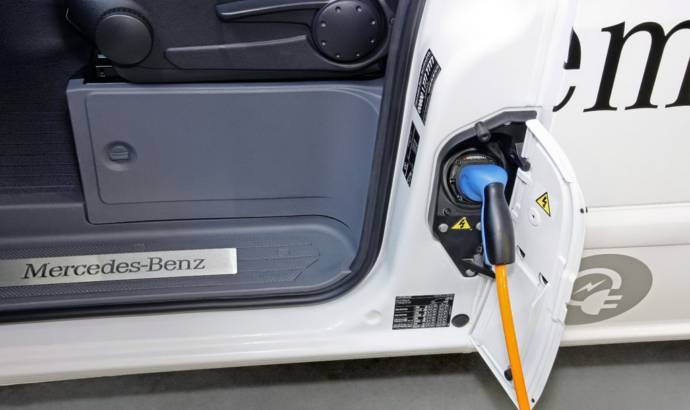
28 Jul 2010
1
2011 Mercedes Vito E-CELL
1 Comment
Comments are closed.

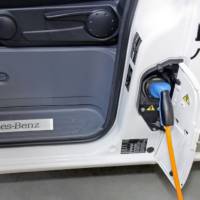
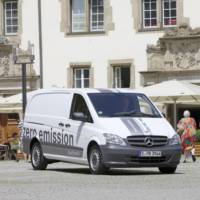
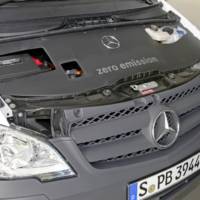
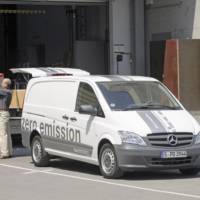
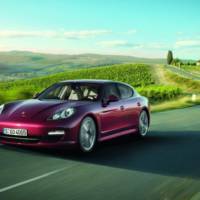
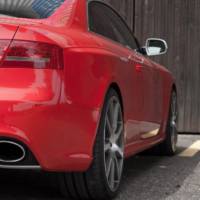
praice please